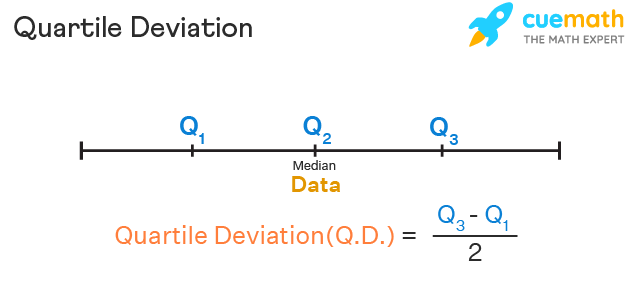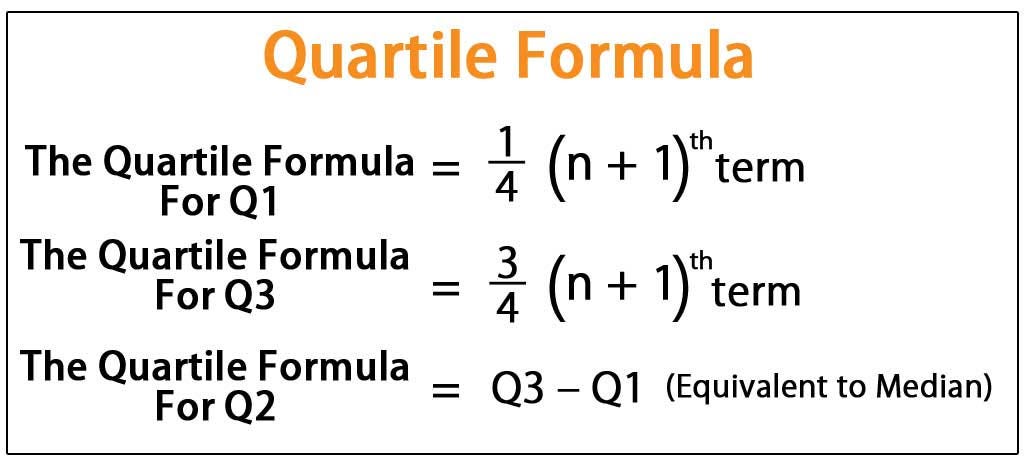The interquartile range is the range of the middle half of a set of data. The standard deviation is affected by extreme outliers.

Quartile Deviation Definition Formula Examples
Q 1 - It is the middle value in the first half of the rank-order data.

. 22 The computed r for the scores in Math and English is 095. It is the difference between the upper quartile and the lower quartile. In some data sets the data values are concentrated closely near the mean.
The first quartile Q 1 is the middle number between the smallest number and the median of the data. Determine the measures of center for the data mean median and mode and explain which one describes the center of this data best. An important characteristic of any set of data is the variation in the data.
A measure of variation is a summary statistic that represents the amount of dispersion in a dataset. A small IQR and a big range maximum - minimum b. While a measure of central tendency describes the typical value measures of variability define how far away the data points tend to fall from the center.
InterQuartile Range IQR When a data set has outliers or extreme values we summarize a typical value using the median as opposed to the mean. 20 Which of the following measures of variation is easily affected by extreme scores. The distance that encompasses any 25 of the observations.
Determine measures of variation range standard deviation and variance and explain which one describes the spread of this data best. The lower quartile is the same as the median. For example an extremely large value in.
The distance that encompasses any 50 of the observations 5. The distance where the middle 50 of the data fall. Q ½ Q 3 Q1 Merits of.
Q 3 denotes the upper quartile and Q 1 indicates the lower quartile. The interquartile range is a measure of variability based on splitting data into quartiles. For example an extremely small or extremely large value in a dataset will not affect the calculation of the IQR because the IQR only uses the values at the 25th percentile and 75th percentile of the dataset.
A quartile is a statistical term describing a division of observations into four defined intervals based upon the values of the data and how they compare to. Quartiles divide the set into 4 equal parts. In other data sets the data values are more widely spread out from the mean.
And they are represented by Q 1 Q 2 and Q 3. 80 72 77 80 90 85 93 79 84 73 87 67 80 86 92 88 86 88 66 77 a. Q 2 - It is the median value in the set.
Recognize describe and calculate the measures of the spread of data. Quartile Deviation is also known as the Semi Interquartile range. Which of the following best describes the interquartile range mid-spread.
Also it is a calculation of variation while dividing a data set into quartiles. Q 3 - It is the. Here quartile deviation can be represented as QD.
The distance that encompasses any 75 of the. The values that split each part are known as the first second and third quartile. The primary reason we use these statistics is to communicate our findings to represent as much of importance as we can.
Up to 10 cash back The upper and lower quartiles can be used to find another measure of variation call the interquartile range. The third quartile Q 3 is the middle number between the median and the largest number. That said each of.
Variance standard deviation and range. Quartile deviation or semi-inter-quartile deviation is. When a data set has outliers variability is often summarized by a statistic called the interquartile range which is the difference between the first and third quartiles.
We talk about variability in the context of a distribution of values. It is a measure of statistical distribution which is equal to the difference between the upper and lower quartiles. The second quartile Q 2 is the median of the data set.
The quartiles divide a data set into quarters. The distance where the upper 50 of the data fall. The Quartile Deviation can be defined mathematically as half of the difference between the upper and lower quartile.
The interquartile range IQR is not affected by extreme outliers. Thus it measures the variation in the middle 50 percent of the data and unlike the range it is not affected by extreme values. 21 Which of the following measures of central tendency is easily affected by extreme scores.
Rank the following three data sets by the value of the IQR. There are three quartiles Q1 Q2 and Q3 where Q2 is the median of the distribution. In contrast to the range which measures only differences between the extremes the inter quartile range also called mid spread is the difference between the third quartile and the first quartile.
The interquartile range IQR is the difference between the upper and lower quartile of a given data set and is also called a midspread. Quartile divides the range of data into four equal parts. An IQR equal to the range c.
The interquartile range is the best measure of variability for skewed distributions or data sets with outliers. Every dataset can be described using these 5 numbers. Interquartile range Q 3 Q 1.
Because its based on values that come from the middle half of the distribution its unlikely to be influenced by outliers. In the above example the interquartile range is 35. So theres really no one way to answer your question because its not a math question its a question of how to communicate.
Here are the number of fries in each of the bags from Restaurant A.

Interquartile Semi Interquartile And Midquartile Ranges

Quartiles Deciles And Percentiles By Mohamed Abdelrazek Medium

Explore Your Data Range Interquartile Range And Box Plot Make Me Analyst
0 Comments